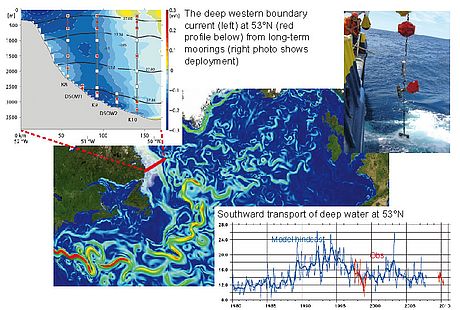Mission:
To determine the dynamics governing the ocean’s role in decadal to centennial climate variability and change based on joint application of modern ocean observing systems and high-resolution ocean modelling. To contribute to the design of optimal long-term observing systems and modelling capabilities, allowing regional evolution projection of key ocean quantities during the 21st century.
Scientific Questions
Major aspects of climate variability and change are associated with ocean dynamics, in particular the ocean’s storage and transport of heat and of radiatively active gases such as CO2. Understanding the mechanisms governing the variability of the ocean circulation is a prerequisite for developing credible projections of future changes in regional ocean properties relevant for marine life and society.
- What is the origin of large-scale ocean circulation variability on decadal to centennial timescales?
- What are the critical requirements for an ocean observing system in order to detect gradual changes associated with anthropogenic trends?
- What are the regional impacts of ocean circulation changes for heat content, sea level, dissolved oxygen, biogeochemistry and marine ecology?
Contents and Goals
The large thermal inertia and its ability to transport mass and other properties over long distances enable the ocean to play a key role with respect to decadal and longer-timescale climate variability. Within the last decades, ocean properties have exhibited noticeable changes. Improved understanding of the underlying dynamics and the associated physical processes through regional and global observation, fundamental theory and their satisfactory representation in ocean models is a requirement to assess ongoing change and to develop credible scenarios for the next decades and centuries.
Modern observations have demonstrated a broad variability spectrum of major ocean currents, as a combined result of atmospheric forcing associated with major modes of climate variability (explored in WP2) and internal ocean dynamics, particularly due to intense mesoscale eddy fields. Of special significance is the detection of slowly evolving anthropogenic signals in the basin-scale, top-to-bottom global overturning circulation, which - in the presence of strong natural variability - challenges observational systems and modelling capabilities.
The main goal of the research programme is to determine the decadal to centennial variability in major ocean circulation systems, and to identify the dynamical processes governing this variability. Particular foci are:
i) Atlantic Meridional Overturning Circulation (AMOC), which alteration under gradually changing atmospheric conditions would have major impacts on the climate of northwestern Europe, on marine life and sea level on European continental shelves;
ii) Quantification and origin of changes in subtropical-tropical ocean circulation, and their implication for regional sea level, sea surface temperatures, and the nutrient supply and oxygen availability in the biologically highly productive tropical ocean regimes; and
iii) Overturning circulation across the Antarctic Circumpolar Current (ACC) and its possible response to intensifying Southern Hemisphere westerlies (as projected by climate models), which would have major consequences for the future oceanic CO2-uptake (or release) with important repercussions for global warming.
Research Highlight 1: A key site for determining the AMOC is the boundary current system along the continental slope off Labrador. Our previous research efforts based on multi-year observations and ocean modelling confirmed that this region represents a natural bottleneck, effectively channelling all deepwater masses formed in the northern Atlantic before eventually being exported into the subtropical Atlantic, and also demonstrated a great potential for detecting long-term trends because of an exceptionally high signal-to-noise ratio. In the next years, we will explore this potential by building on the existing observation system in combination with improved numerical simulations utilising the recent developments in our high-resolution (1/20°) model hierarchy.
Research Highlight 2: A global analysis of the 100-year regional trend of sea surface temperatures reveals significant differences. For instance, all western boundary currents, including the Gulf Stream, warmed three times as much as the global average. The most likely explanation is a pole-ward displacement of all boundary current systems. Understanding past and ongoing regional circulation changes and their consequences for cross-gyre exchanges and regional budgets of heat and salinity is critical for evaluating the future ocean and climate states, including the AMOC. Joint analysis of sustained ocean observations, regional enhanced global ocean and climate models are planned to narrow the uncertainty in the prediction of future regional ocean changes.
Research Highlight 3: Recent research highlighted the important role of anthropogenic trends due to the progressive pole-ward shifting of the Southern Hemisphere westerlies projected by climate modelling scenarios. This could become a major factor for the future stability of the AMOC due to concurrent shifts in the Agulhas Current, and thus, to the supply of warm and salty waters from the tropical Indian Ocean. Corresponding changes would also affect the uptake (or release) of anthropogenic CO2 as well as trends in the supply of oxygen and nutrients to the equatorial upwelling zones. Future research will build on previous work using historic and modern data (i.e., ARGO profiling floats). New developments in coupled ocean-biogeochemistry model systems will be integrated in the main research programmes on future AMOC and tropical ocean trends.



